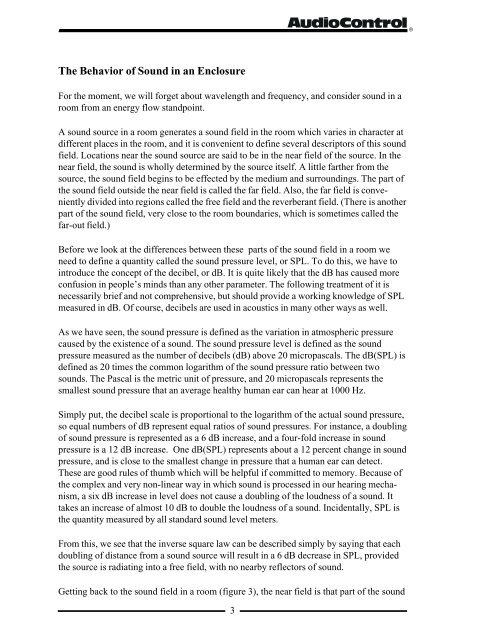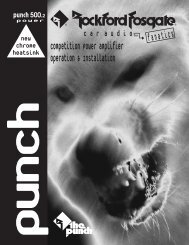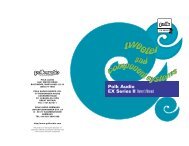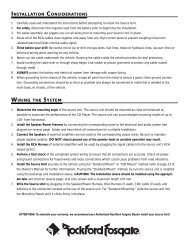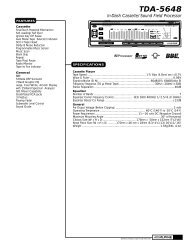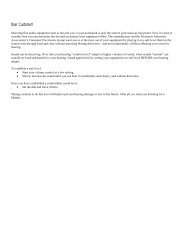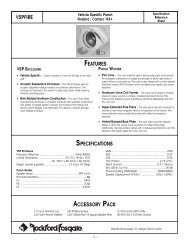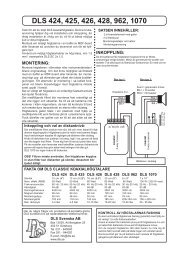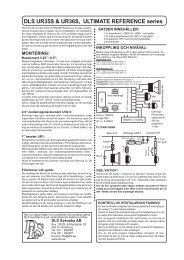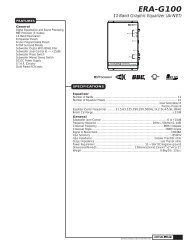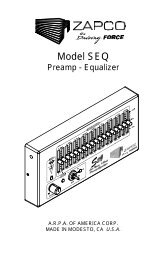Small Room Acoustics De-Mythologized - Eporia
Small Room Acoustics De-Mythologized - Eporia
Small Room Acoustics De-Mythologized - Eporia
You also want an ePaper? Increase the reach of your titles
YUMPU automatically turns print PDFs into web optimized ePapers that Google loves.
®The Behavior of Sound in an EnclosureFor the moment, we will forget about wavelength and frequency, and consider sound in aroom from an energy flow standpoint.A sound source in a room generates a sound field in the room which varies in character atdifferent places in the room, and it is convenient to define several descriptors of this soundfield. Locations near the sound source are said to be in the near field of the source. In thenear field, the sound is wholly determined by the source itself. A little farther from thesource, the sound field begins to be effected by the medium and surroundings. The part ofthe sound field outside the near field is called the far field. Also, the far field is convenientlydivided into regions called the free field and the reverberant field. (There is anotherpart of the sound field, very close to the room boundaries, which is sometimes called thefar-out field.)Before we look at the differences between these parts of the sound field in a room weneed to define a quantity called the sound pressure level, or SPL. To do this, we have tointroduce the concept of the decibel, or dB. It is quite likely that the dB has caused moreconfusion in people’s minds than any other parameter. The following treatment of it isnecessarily brief and not comprehensive, but should provide a working knowledge of SPLmeasured in dB. Of course, decibels are used in acoustics in many other ways as well.As we have seen, the sound pressure is defined as the variation in atmospheric pressurecaused by the existence of a sound. The sound pressure level is defined as the soundpressure measured as the number of decibels (dB) above 20 micropascals. The dB(SPL) isdefined as 20 times the common logarithm of the sound pressure ratio between twosounds. The Pascal is the metric unit of pressure, and 20 micropascals represents thesmallest sound pressure that an average healthy human ear can hear at 1000 Hz.Simply put, the decibel scale is proportional to the logarithm of the actual sound pressure,so equal numbers of dB represent equal ratios of sound pressures. For instance, a doublingof sound pressure is represented as a 6 dB increase, and a four-fold increase in soundpressure is a 12 dB increase. One dB(SPL) represents about a 12 percent change in soundpressure, and is close to the smallest change in pressure that a human ear can detect.These are good rules of thumb which will be helpful if committed to memory. Because ofthe complex and very non-linear way in which sound is processed in our hearing mechanism,a six dB increase in level does not cause a doubling of the loudness of a sound. Ittakes an increase of almost 10 dB to double the loudness of a sound. Incidentally, SPL isthe quantity measured by all standard sound level meters.From this, we see that the inverse square law can be described simply by saying that eachdoubling of distance from a sound source will result in a 6 dB decrease in SPL, providedthe source is radiating into a free field, with no nearby reflectors of sound.Getting back to the sound field in a room (figure 3), the near field is that part of the sound3


